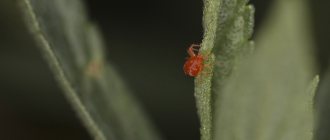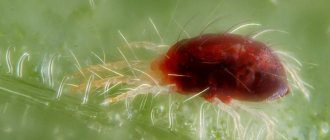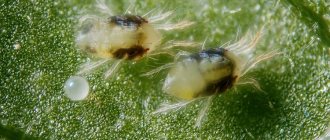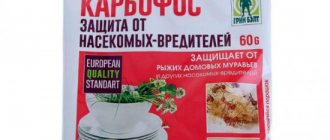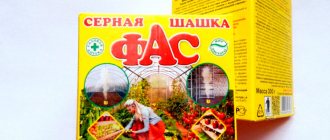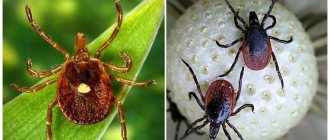Spider mites are a dangerous pest that affects cucumbers in the garden and greenhouse. Small colonies grow at tremendous speed and completely take over plantings. Already seven days after the spider mite appears on the site, it can be detected by traces of vital activity on the greenery. Then a cobweb appears on the leaves, in which colonies of insects are located.
In this material we will take a detailed look at the main methods of controlling spider mites on cucumbers in a greenhouse. We will tell you about effective insecticides, biological preparations, folk remedies and frequency of use. You will learn how to use agricultural techniques to prevent infection of cucumbers in a closed space.
General information about insect pests
The only way to see what a spider mite looks like is through a magnifying glass or in a photo, it is so small. The length of the red or brown body of the tiny insect does not exceed 0.5 mm. Spider mites in the larval stage have 3 pairs of tiny legs, and adults have 4.
The larvae have a greenish body color with dark spots on the sides. For the winter, spider mites hide underground. These insects love dry air and high temperatures. In such conditions, larvae emerge from eggs within 3-4 days after laying.
The lifespan of spider mites does not exceed three months, but during this time they manage to multiply greatly. Bugs live on the underside of leaves, bite through them and suck the juice from the plants. Their presence is detected by the appearance on the surface of cucumber leaves of light spots with veins and a thin matte web.
In addition to causing harm through its own efforts, the mite also spreads spores of gray rot, which is very difficult to get rid of.
Spider mites in greenhouses and open ground: signs and causes of appearance on cucumbers
The spider mite is a leaf-sucking insect belonging to the species of mites, the spider family. Therefore, to combat the pest it is necessary to use acaricides - means to combat ticks.
Spider mites suck juices from plant leaves. As a result, they turn yellow (turn brown), then curl up, dry out and fall off.
The main thing is to detect the pest in time and apply the necessary measures.
The mite is very small (0.3-0.6 mm in length), so it is difficult to notice on plants.
However, its presence on cucumbers can be determined by certain signs:
- There are small cobwebs on the back of the leaves.
- Pale yellow dotted spots have appeared on the front side, which eventually merge into one spot.
Important! Do not confuse the tick with peronosporosis (downy mildew) and thrips.
Most often, spider mites appear in dry and hot weather at an air temperature of about +30 degrees, especially during drought. Therefore, it can more often be found on cucumbers in the southern regions.
By the way! Spider mites also often attack eggplants, currants and strawberries, petunias, roses and hydrangeas.
Accordingly, the best conditions for spider mites are greenhouse conditions.
Interesting!
Mites actively reproduce on plants that fatten from excess nitrogen. But plants receiving excess phosphates do not attract pests.
Pest appearance
Spider mites begin their invasion of cucumber beds in the spring, when the soil has warmed up sufficiently. The larvae crawl out of the ground and attack the young, succulent greenery of garden plants.
Also, spider mites can appear on cucumbers along with seedlings. This happens if the gardener is too lazy to treat the soil before sowing the seeds.
It is important to know that the microclimate in greenhouses and greenhouses is very favorable for the pest.
Pest resistant cucumbers
Breeders have developed varieties that are immune to spider mites and diseases. The early ripening hybrid "Benefis" is unpretentious in terms of care and is not afraid of parasites and fungi. The productive plant actively bears fruit until the cold weather and pleases farmers with delicious cucumbers.
The Rodnichok variety loves abundant irrigation and a lot of light. Its characteristic is resistance to pests and diseases. The foliage and lashes of the bush have an unpleasant aroma for spider mites, which repels them from the garden bed. If you follow the rules of agricultural technology, you can get an excellent harvest from such cucumbers.
The universal hybrid “Murashka” grows well both in a greenhouse and in open ground. A productive species with strong immunity from parasites and fungal diseases shows good results with minimal care. The fragrant fruits with a pleasant taste are used fresh and canned.
Spider mites on cucumbers are a dangerous pest that affects plants in greenhouses and gardens. To get rid of an insect, you need to combine chemical and biological preparations with folk remedies. If you do not violate the rules of agricultural technology and do not forget about prevention, then you don’t have to be afraid of massive mite damage to your plantation.
Ways to combat spider mites
If affected cucumber leaves are found, they must be torn off and burned. This method of control does not provide a complete guarantee that the pest will not appear on other leaves or bushes of cucumbers, however, this must be done. If the entire plant is affected, then it must be uprooted and also burned. The soil under it should be watered with a weak solution of potassium permanganate.
If spider mites are detected early, when the cucumber leaves have not yet begun to wither, but there are already signs of the pest, you can wipe the leaves with a napkin soaked in a solution of hydrogen peroxide, turpentine or ammonia.
The best way to combat spider mites is to spray with biologically active preparations of systemic action. Three or four treatments are enough to completely get rid of these pests. Such protective equipment must be used in strict accordance with the instructions.
Before spraying, be sure to remove all the cobwebs from the leaves, if they have not yet withered. Dry leaves should be torn off and burned; there is no point in treating them.
If the mite on cucumbers has proliferated excessively, then you can’t do without chemicals. Don't forget that these are toxic substances and harm people. They should only be used as a last resort.
Signs of fruit damage
The main signs of spider mite infestation of cucumbers include the following:
- formation of light spots on the leaves. If the parasite remains on the plant for a long time, a large number of spots also appear on the back side of the leaf blades;
- the plant is entwined with an almost invisible web;
- the growth of vegetable crops slows down;
- the leaves begin to turn yellow quickly;
- the base of the plant begins to wither and dry out;
It is extremely important to detect spider mites as early as possible, which will allow you to quickly cure the plant and avoid its death from infection with the parasite.
Handy means of protecting cucumbers
An aqueous solution of 3% hydrogen peroxide is a good weapon against spider mites. To prepare one liter of solution, only 40 ml of peroxide is required. You can sprinkle cucumbers with it 3-4 times with a week break. If the heat is above 30 degrees, then spraying is allowed after 3 days.
Exactly the same solution can be made with ammonia. The preparation proportions and frequency of use are similar.
How else to get rid of spider mites, and at the same time from other pests? For example, using turpentine. It needs to be poured into jars, placed on the garden bed and covered with film over the entire crop. Under the influence of turpentine vapors, pests will die within a few hours.
You can also expel spider mites from cucumber leaves using tobacco dust. You need to lightly sprinkle the area with it - the pests will leave it. For prevention, gardeners also use tar soap cooked with birch tar.
Plants that repel pests
In nature, there are plants that spider mites are terribly afraid of; they even die from exposure to infusions from them.
- To treat large areas, it is better to use Datura decoction rather than infusion. To prepare 10 liters of the product you will need 1 kg of dry or 3 kg of fresh dope without roots. This amount must be brought to a boil and simmered over low heat for 3 hours. After cooling at room temperature, the broth is filtered and squeezed. Cucumbers can be sprayed with it every 5 days until the spider mite completely disappears. To treat small beds it is easier to use dope infusion. You need to take 100 g of dry grass, add a liter of water, and let it brew for a day.
- Dandelion infusion is even easier to make. To do this, you need to chop 0.5 kg of dandelions, fill them with 10 liters of water, and let them brew for 3-4 hours. You can use not only flowers, but also leaves and stems of the plant.
- To prepare a calendula infusion, you need to take 400 g of dried flowers (they are sold in all pharmacies), add 4 liters of water, and let it brew for 5 days.
- Please note that only roots are used to prepare sorrel decoction ; leaves are not suitable for this. The infusion is prepared in just 5 hours. Dosage - 300 g of roots per 10 liters of water.
- Not an infusion, but a decoction is made from yarrow It is also very simple to prepare. You need to take 500 g of dry yarrow, pour 5 liters of water into it, and bring to a boil. After cooling completely at room temperature, the broth is filtered, squeezed, and water is added to obtain a volume of 10 liters.
- Onions and garlic are also suitable for treating cucumbers against spider mites. To prepare the infusion, onion or garlic peels are usually used. 200 g of husks are poured with 10 liters of water and left to infuse for a day. Then the mass is filtered and squeezed out.
You can prepare a composition of garlic arrows, as in this video:
All these folk remedies cannot be used in sunny weather. They are used to treat cucumbers after sunset. The fact is that under the influence of sunlight, toxins formed in infusions and decoctions quickly lose their properties.
How to fight
In the early stages of infection, isolated outbreaks can be combated manually by brushing off the parasites with a damp rag. To prevent the pest from multiplying, it is necessary to increase the humidity in the greenhouse to 80%.
The life cycle of a tick is less than a month, but during this time the adult tick manages to lay eggs several times. At the same time, she lays about 400 eggs at a time.
Before you start processing the plant, you need to cut off the yellowed parts. If a large part of the crop is affected, it is worth digging it up and destroying it. This will help prevent it from spreading to neighboring plants.
Chemicals
Acaricidal drugs are toxic agents, so they are recommended to be used in extreme cases. They guarantee the rapid death of parasites and affect not only adults, but also larvae and eggs.
Floramite . The main active ingredient of the drug is biphenazate. Release form – suspension concentrate. The principle of action of Floramaite differs from other acaricides used to treat plants. The ticks become hyperactive and stop feeding within 3 hours. The residual effect affects the insect colony for the next 3-4 days.
If the drug is used incorrectly, ticks may develop resistance to it. Therefore, it should only be used once a year. The use of this product should be combined with the application of other chemicals. Rain or watering 6 hours after using Floramaite does not reduce its effectiveness, which makes it stand out from other products.
Plant Pin . Plant-Pin sticks are produced in the Netherlands. The main active ingredient is butoxycarboxim. There are 20 records in a package. An insect repellent, primarily used for indoor plants, but will help rid greenhouse cucumbers of spider mites.
You need to use 1 plate for every 9 square cm. You need to stick the sticks a couple of cm from the stem of the cucumbers. When watering a plant, the drug dissolves in the soil and is absorbed by the roots. The product begins to have an effect on insects within 7 days and protects the crop for 7 weeks.
Etisso . The package contains 10 sticks. The method of application is similar to Plant-Pin, but the main active ingredient in Etisso is dimethoate. For every 10 square cm, 1 stick is required. The stick dissolves in water and is absorbed by the roots. The first results appear in a few days. Protects for 3 months. It is considered a low-hazard substance.
When working, you should follow general safety requirements and use gloves. After use, you must wash your hands with soap. Avoid ingestion and keep away from children.
Apollo . Apollo is a contact acaricide with a specific action that can cope not only with adult ticks, but also with tick eggs. The drug is non-toxic to humans and has a slight odor. The product is valid for up to 2 months after use. Destroys tick larvae and eggs, but does not kill adult individuals, but only sterilizes them, which reduces the population.
Nissoran is an acaricide whose active ingredient is hexythiazox. Does not affect adults, destroys tick larvae and nymphs. The drug has a translaminar mechanism of action, which allows it to reach hard-to-reach places. Protects after use for up to 2 months. Ticks do not develop resistance to the drug.
The product affects the intestines of pests and the hormonal system, sterilizes insects. After spraying, the larvae and eggs die immediately. Adult ticks continue to live, but even if they lay eggs, no one will hatch.
Oberon is a contact insectoacaricide belonging to hazard class 3. The main active ingredient is spiromesifen. This hormonal drug has no effect on adults, but kills eggs and larvae. Has the effect of incomplete sterilization of eggs (up to 50% of the population). It acts faster outdoors than in a greenhouse. Virtually odorless.
Karbofos is a contact-intestinal organophosphorus insectoacaricide. The active ingredient is malathion, which is odorless and tasteless. A special flavor is added to the drug to prevent accidental poisoning. When it gets on the body of an insect or in its intestines, malathion turns into a toxic substance that kills the pest within a few hours.
The product is safe for eggs. Protective effect is about a week in a greenhouse and up to 10 days outdoors. Karbofos quickly disintegrates in air, water and soil without poisoning them.
Aktellik . The main active ingredient in Actellik is pirimiphosmethyl. Release form: emulsion concentrate. For a liter of water you need to take one ampoule of the substance and mix thoroughly. Do not use food containers to prepare the solution. It is recommended to take a plastic bucket that is used exclusively for treating plants.
It is necessary to work in safety glasses, rubber boots, gloves and a respirator. The duration of treatment should not exceed 3 hours. After working with Actellik, you should wash your face and hands with soap and rinse your mouth. The drug should be stored away from medications and food products, out of reach of children and animals.
Fufanon is an insecticide with contact-intestinal action. The main active ingredient is malathion. It has a protective effect for 3-14 days. Release form – emulsion concentrate in ampoules of 5 ml or bottles of 10 ml.
5 ml of product must be diluted in 5 liters of water. Insects that have consumed the product as food develop paralysis, they stop feeding and die within 24 hours. Resistance to the drug may occur, so use should be alternated with other insectoacaricides.
Demitan is an acaricide against herbivorous mites. The main active ingredient is phenazachine. Helps cope with insects at all stages of their development. Provides tick population control for 1 month. Pests do not develop resistance to the drug. It is a low-toxic product for beneficial insects and entomophages.
Treatment of plants with chemicals must be carried out using safety measures. Wear protective clothing, a mask and goggles to protect your respiratory system, eyes and skin.
Biological agents
Biological agents are considered a modern replacement for chemicals. They act exclusively on the pest, but do not harm the plant itself.
Fitoverm is an enteric contact insectoacaricide. It begins to act when it enters the tick’s body or its esophagus. As a result of exposure, the central nervous system of the insect is paralyzed, paralysis occurs, which leads to its death.
A few hours after treatment in a greenhouse and half a day after treatment in open ground, the drug begins to act. Its protective properties remain in greenhouse conditions for 1-3 weeks, and in the garden - up to 2 weeks. Fitoverm works better at high temperatures.
Among the advantages of the drug is that it is quickly removed from the fruit. Cucumbers can be harvested after 3 days. But the product also has a disadvantage - the tick quickly develops an addiction to the main active ingredient, so Fitoverm is recommended to be used only during an important period of plant development.
Vertimek is an enteric-contact insectoacaricide. The drug acts on the insect at any stage of its development and inhibits vital activity. A couple of hours after treatment, it penetrates the plant tissue. Continues to operate for 3 weeks.
Kleschevit is an insecticide whose main active ingredient is aversectin C. Once ingested by an insect, the functioning of the central nervous system is disrupted, causing paralysis within 5 minutes. The death of the parasite occurs after half an hour. In a greenhouse, the product continues to act for up to a week and a half, and in an open space – up to a week.
The drug shows the greatest effectiveness at temperatures above 30 degrees Celsius. At air temperatures below 20 degrees Celsius, the product becomes ineffective. Kleshchevit shows the result of exposure only on adult individuals. Parasite eggs and larvae that have not yet begun to feed on plant sap will not be harmed.
It is not recommended to use the product more than 3 times in a row, since insects develop resistance to the main active ingredient.
The advantages of Kleschevit include the low toxicity of the substance. On the leaves, the product is destroyed within 3 days, and on the fruits – within 2 days.
Akarin is a fast-acting enteric-contact insectoacaricide. Depending on the air temperature, the parasites die within 4 to 8 hours after using the drug. Its action has a cumulative effect, but unlike Fitoverm, ticks do not develop resistance to it. Therefore, this remedy can be used often without fear of reducing its effectiveness.
Akarin is an extract from the streptomyces fungus. It contains components that help in the fight against various pests. The drug is available in 1 liter ampoules and bottles. The pack contains 4 ampoules. To process cucumbers, you need to dilute 2-8 ml of the substance per liter of water. It is recommended to dilute the solution in a plastic bucket, used exclusively for treating the plant.
It is recommended to spray before 10 a.m. or after lunch. The air temperature during processing should be within 15-25 degrees Celsius. Do not treat plants before or after rain.
Aktoverm . Actoverm contains Avrsectin C, which can affect the central nervous system of insects. After penetration into the body of a tick, the drug affects the nervous system, causing paralysis, which leads to the death of the pest. It takes 1-3 days for the first signs to appear. Mass death occurs within a week.
The biological product affects larvae of different ages. Spraying should be done during the growing season of cucumbers. The optimal air temperature should be 20-35 degrees Celsius. 2 days after application you can harvest. The solution should not be stored for more than 6 hours after preparation.
Bitoxibacillin has an intestinal effect, causing insects to stop feeding and begin to die within a couple of days. It also reduces the fertility of females. It is a moderately hazardous substance and is safe for beneficial insects and bees. Can be used at any phase of plant development, but 5 days before harvest. Treatment must be carried out at an air temperature of 18-30 degrees Celsius at intervals of a week.
Folk remedies
Folk remedies are the safest way for humans to get rid of spider mites. The methods only work if the pest spread is insignificant. For large foci of infection, it is worth using biological and chemical agents.
Before using liquid preparations and solutions, it is necessary to remove cobwebs from plants, since they have moisture-repellent properties and protect insects from poison, which reduces the effectiveness of treatment.
Hydrogen peroxide . For a liter of water you need to take 3 tablespoons of 3% hydrogen peroxide. For ease of preparation, it is recommended to mix the liquids directly in the spray bottle with which the spraying will be carried out. At least 3 treatments will be required. when fighting spider mites in open ground, the interval between sprayings should be 7 days, and in a greenhouse - 3 days.
Ammonia . For a liter of water you need to take 3 tablespoons of ammonia and mix the solution thoroughly. The resulting liquid should be sprayed on the plants 3 times, maintaining an interval between treatments of 3-7 days.
Garlic . In 10 liters of hot water you need to add 30 g of ground garlic pulp and let the solution brew for 24 hours. After this, the product must be filtered and sprayed on the affected plants.
Hot peppers . You need to pour a liter of water into a pan and put it on fire. When boiling, add 100 grams of hot pepper to the container and boil for about an hour with the lid closed. After this, you need to remove the pan from the heat and leave the solution to infuse for a couple of days. Then the concentrate is filtered and diluted with 10 liters of clean water.
Tobacco dust . Tobacco dust must be used to combat spider mite larvae, which cannot cause significant damage to the plant. You just need to sprinkle this powder on top of the cucumbers. The product will not harm the crop, but will be harmful to insects.
Cinnamon . To prepare the solution you will need the following ingredients:
- ground cinnamon (1 tsp);
- cloves (1 tsp);
- Provençal herbs (2 tsp);
- gruel of ground garlic (2 tbsp);
- water (1 l);
- liquid soap.
You need to mix the spices thoroughly and pour boiling water over them. After the resulting spicy solution has cooled, you need to add garlic to it. After an hour of infusion, it is worth straining the product, adding a small amount of liquid soap and treating the plantings.
Ash . Ash is not used as an individual means of pest control. It must be used as an additional remedy if the cucumber leaves have turned yellow or become deformed. Sprinkle with planting powder after treatment with other preparations.
Iodine . You need to mix 100 ml of milk with a liter of warm water, add 10 drops of iodine to the solution. Treatment must be carried out in the absence of sunlight, which can leave a burn on the leaves.
Celandine . You only need 1 teaspoon of herb per 1 cup of boiling water. As soon as the product has cooled, you need to moisten a rag in it and treat each sheet. It is worth considering that this is problematic to do over a large area, so it is more suitable for combating ticks in greenhouse conditions.
Vodka . For half a liter of water you need to take 2 tablespoons of vodka. The leaves of the plant need to be treated with a rag soaked in the solution.
Zelenka . To prepare the solution you will need 1 teaspoon of brilliant green, 2 tablespoons of hydrogen peroxide per 1 liter of water. The plant will need to be sprayed with the product several times (usually at least 4 times). In this case, breaks between treatments should be 5-7 days.
Soap solution . Using a soap solution, you can get rid of insects both in the greenhouse and in the open ground. It is recommended to use laundry or tar soap in a bar for these purposes. It needs to be grated and dissolved in warm water. The solution sticks to the leaves of the plant, thereby creating a barrier that does not allow ticks to feed, and therefore they die of starvation.
To prepare the solution you need:
- Dissolve 200 g of soap in 10 liters of warm water.
- Leave for 3 hours for the solution to infuse.
- For the best effect, it is recommended to add 50 ml of a decoction of tobacco dust or alcohol.
- Spray the resulting solution onto the crop.
- Do 3 procedures with a break of a week.
If folk remedies do not help get rid of pests, you should start using stronger and more effective drugs.
Ammonia . Ammonia and ammonia are two different things. The first is a concentrated substance; ammonia is made from it. 30 ml of the substance must be dissolved in a bucket of water. Then you need to moisten a piece of rag in the resulting solution and treat the cucumber leaves on both sides.
Turpentine . Spider mites do not tolerate the smell of turpentine. You need to place jars with this substance between the plants and tie the necks with cloth. Turpentine fumes will destroy pests in a few days.
Features of processing in a greenhouse
First of all, you need to read the instructions for use of the drugs. Often biological products are marked at what air temperature they should be used. It is also necessary to pay attention to the frequency of spraying.
Several treatments are needed. Many products do not kill insect eggs, and therefore subsequent spraying should be carried out approximately 5 days after the previous one. At the same time, depending on the stage of development of the tick, it is worth using different drugs.
Features of processing in open ground
When processing cucumbers in open ground, you must adhere to the following rules:
- Plants should be sprayed early in the morning or late in the evening. In cloudy and windless weather, processing can be done during the day.
- It is necessary to collect all ripened fruits before processing.
- It is necessary to process the bottom part of the sheet first, and then the top.
The remaining rules are the same as those that should be followed when growing cucumbers in a greenhouse.
Control measures during fruiting
It is not recommended to use chemicals during fruiting. Biological agents contain information in their description about the period during which they are completely eliminated from the fruit. But you can use insect predators to combat spider mites, which will not destroy the crop, but will get rid of the pest.
| Name of insect predator | Description of appearance | Behavior |
| Ladybug | The length of the predator's body is from 1 to 1.8 cm. There are black round spots on the red back. Has 6 limbs. | Destroys various types of pests. It waits out the winter under fallen leaves in a flock to keep it warmer. It is most active in the spring. |
| Neoseiulus californicus | Parasitiform mites are small in size (up to 0.5 mm). It has a pale orange, peach, pink color. Translucent larvae have 6 legs. | Females lay up to 4 eggs per day, which take up to 4 days to develop. In the protonymph phase, the larvae do not require nutrition. Adults live about 20 days. They actively develop at temperatures of 10-33 degrees Celsius. They eat many small insects, including spider mites. |
| Phytoseiulus | A predatory mite measuring about 0.2-0.8 mm. Covered with 30-36 pairs of setae. The oval-shaped body is divided into two red sections. | Lives at temperatures above 20 degrees Celsius. Prefers a humid habitat. During her life, one female lays about 1 hundred eggs. |
Plants that repel pests
An additional measure to combat insects is to plant repellent plants in the immediate vicinity, that is, plants that repel spider mites. This:
- tomatoes;
- dill;
- marigold;
- garlic;
- cilantro;
- beans;
- chrysanthemums.
Spider mites will react negatively to the proximity of cucumbers to wormwood and tansy. These herbs have a strong odor, as well as a large amount of essential oils, tannins, flavonoids, and bitterness in the composition. The smell of lavender can repel not only ticks, but also moths, midges and mosquitoes. It is also worth planting cereal crops between beds or greenhouses, since this is an unfavorable environment for the development of mites.
Biological remedies
Biologically active drugs are not chemical. The bacteria they contain enter the plants without causing them any harm. At the same time, they are deadly for spider mites and a number of other insects. After these bacteria enter the tick’s body along with the juice, the insect becomes ill and soon dies.
The real result with the use of biological products occurs 12 hours after spraying. Such drugs act for a long time. There are a lot of them, but the principle of operation is the same for all. The most popular among gardeners are the preparations “Bi 58”, “Aktofit”, “Vertimek”, “Akarin”, “Agravertin” and “Kleschevit”.
You should know that spider mite eggs laid underground, as well as the larvae located there, are not exposed to biologically active drugs.
The use of these protective agents for different plants should be carried out differently. So read the instructions carefully and strictly follow their instructions.
How to properly spray cucumbers against spider mites
Processing rules:
- The procedure is carried out early in the morning or late in the evening. This can also be done during the day in calm and cloudy weather.
Advice! Read the instructions, since biological agents and others are effective only at high air temperatures.
- First, all the ripe fruits are collected, then sprayed.
- First, the inside of the sheet is processed, and then the top.
- The tick has several stages of development, so it is necessary to use different drugs depending on its phase.
- Spraying is carried out at a certain frequency: at +12-20 degrees - once every 15 days, at +20 and above - once a week.
- The treatment is carried out several times, since many drugs do not kill pest eggs. Hatched ticks will become sexually mature within 3-5 days and will lay new eggs themselves.
- Study the waiting period - the time during which you cannot pick and eat fruits after processing the crop.
Chemical protection products for cucumbers
Such drugs also need to be used strictly according to the instructions, not forgetting that these are poisons. They should be used as a last resort. Cucumbers can be treated with one chemical preparation only once, because the next generation of parasites is already adapted to a specific poison. During the season, 3 generations of spider mites are replaced.
A detailed study of the degree of influence of chemicals on spider mites shows that after the first treatment, half of the insects die. After the second spraying, only 10% of these tiny pests remain alive. That is why the area has to be processed three times with intervals of 4 - 6 days.
Prevention
Spider mites are an insect against which preventive measures should not be neglected. Otherwise, there is a risk of not harvesting at all.
- This insect feels more comfortable in greenhouses and greenhouses than in open ground beds. You can deprive him of such pleasure by maintaining air humidity at 70%. Note that at 60% humidity the tick dies.
- A good prevention is to dig up the area in the fall and spring.
- Spider mites do not like phosphorus fertilizers, so do not forget to feed the cucumbers with them.
- After harvesting, be sure to burn the cucumber tops.
- Keep weeds out of your garden beds.
- Plant several calendula bushes between the cucumber rows.
- An excellent preventative method is to plant cucumbers mixed with cabbage and tomatoes.
If you follow all the recommendations of experienced summer residents, you will not be left without cucumbers.
Olga Danilina

